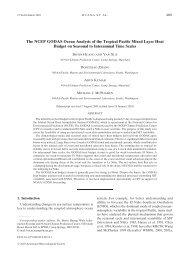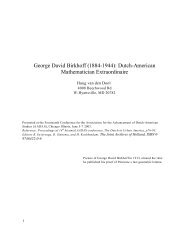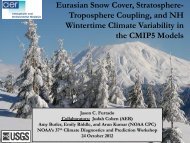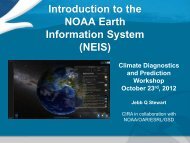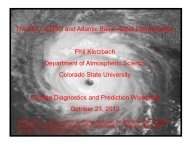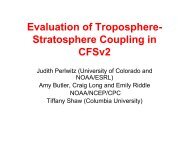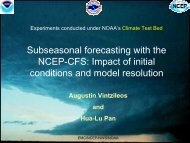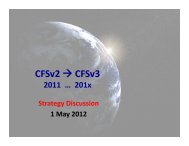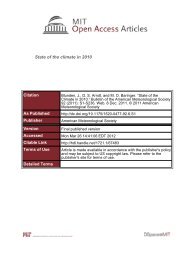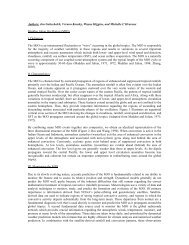Seasonality of the Pacific decadal oscillation - Climate Prediction ...
Seasonality of the Pacific decadal oscillation - Climate Prediction ...
Seasonality of the Pacific decadal oscillation - Climate Prediction ...
Create successful ePaper yourself
Turn your PDF publications into a flip-book with our unique Google optimized e-Paper software.
Figure Captions<br />
Fig. 1. Spatial patterns <strong>of</strong> SST associated with <strong>the</strong> first EOF <strong>of</strong> monthly mean<br />
SST over <strong>the</strong> North <strong>Pacific</strong> (20 o N–65 o N, 125 o E–100 o W) based on <strong>the</strong> (a) OISST data<br />
during 1982–2010, (b) ERSST during 1861–2010, and (c) <strong>the</strong> ensemble average <strong>of</strong> 16<br />
leading EOFs for individual 30-yr segments from <strong>the</strong> 480-year CFS coupled run, and (d)<br />
seasonal distribution <strong>of</strong> <strong>the</strong> percentage variance <strong>of</strong> PC time series with red for <strong>the</strong> OISST,<br />
green for <strong>the</strong> ERSST, orange for <strong>the</strong> PDO index (1900–2010; Mantua et al. 1997), light<br />
blue for 16 individual 30-yr segments, and black for <strong>the</strong> 16-member ensemble. The<br />
spatial patterns in (a,b,c) are displayed in correlation maps in which <strong>the</strong> monthly mean<br />
SST anomalies at each grid point are correlated with <strong>the</strong> corresponding PC time series.<br />
Fig. 2. PDO-related monthly ocean temperature anomalies (shading, o C) and<br />
correlation (contour) with <strong>the</strong> PDO PC time series at 37 o N across <strong>the</strong> North <strong>Pacific</strong> in <strong>the</strong><br />
CFS. The anomalies are obtained by regressing ocean temperature anomaly vs. <strong>the</strong> PC<br />
time series <strong>of</strong> <strong>the</strong> first EOF <strong>of</strong> North <strong>Pacific</strong> SST in individual 30-yr segments. The<br />
anomalies are based on <strong>the</strong> ensemble average <strong>of</strong> 16 members and are associated with one<br />
standard deviation fluctuations in <strong>the</strong> PC time series for months from January to August.<br />
The correlation coefficients are also based on <strong>the</strong> ensemble average <strong>of</strong> <strong>the</strong> 16 members.<br />
Contours are ±0.3, ±0.5, and ±0.7 with negative contours dashed.<br />
Fig. 3. Same as in Fig. 2, but based on 29-yr (1982–2010) ocean temperature<br />
from <strong>the</strong> GODAS and <strong>the</strong> first EOF <strong>of</strong> North <strong>Pacific</strong> SST from <strong>the</strong> OISST.<br />
Fig. 4. Monthly climatology <strong>of</strong> <strong>the</strong> mixed layer depth (MLD; m) in <strong>the</strong> North<br />
<strong>Pacific</strong> derived from <strong>the</strong> CFS coupled run ensemble averaged over 16 30-yr segments for<br />
months from January to August.<br />
Fig. 5. Same as in Fig. 4, but based on 29-yr (1982 – 2010) GODAS data.<br />
Fig. 6. Regression patterns <strong>of</strong> 1000-hPa wind (vectors; m s -1 ) and SST (shadings,<br />
o C) anomalies in <strong>the</strong> CFS associated with one standard deviation departures <strong>of</strong> <strong>the</strong> PC<br />
23




